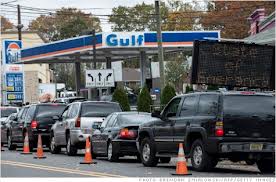 I’d like to reprint in full the most cogent explanation from a public official about the post-storm issues limiting the availability of gasoline across our region. Chris St. Lawrence is the Ramapo (NY) Town Supervisor and former Democratic candidate for Lt. Governor.
I’d like to reprint in full the most cogent explanation from a public official about the post-storm issues limiting the availability of gasoline across our region. Chris St. Lawrence is the Ramapo (NY) Town Supervisor and former Democratic candidate for Lt. Governor.
Since the advent of Hurricane Sandy, Mr. St. Lawrence has provided regular, cogent and informative updates to town residents. I just wanted to share his latest email explaining the gas shortage and what government is doing to alleviate the situation. I believe that with good information comes understanding and patience. H/T to Chris St. Lawrence and his staff for doing both.
From the Desk of Christopher P. St. Lawrence:
I would like to share with you the following report received from the office of Senator Kirsten Gillibrandregarding the current gas shortage.The bottom line is that a number of the factors contributing to the shortage issues have been addressed, but it will probably be another 24 hours or more before the effect is visible.Supply Issues: Majority of the terminals and pipelines that deliver gasoline to the region went down during the storm. Additionally, access to ports was limited by the Coast Guard because of hazardous conditions on the water. The good news is that these problems are being addressed. The Coast Guard has lifted most of their restrictions, enabling significant supplies to reach the region. A number of major pipelines and delivery points have come back online or are expected to do so in the next 24 hours. The combined effect of these re-openings should significantly alleviate the shortage, although it will still take some time for gas to be offloaded and distributed to stations.
- Refining Capacity: Majority of the Northeast regions refineries (primarily located in the Delaware, PA, Southern NJ area) had to shut down as a result of the storm. Many of these are coming back online. The EPA has lifted some Clean Air Act requirements for diesel fuel which should help increase production rate at the refinings that are operating. The re-opening of pipelines and terminals means that gas from the Gulf that has been earmarked for the area can now begin to flow in. In addition, Homeland Secretary Janet Napolitano announced Friday that the Department of Homeland Security issued a temporary, blanket waiver of the Jones Act, allowing additional oil tankers coming from the Gulf of Mexico to enter Northeastern ports, which will provide additional fuel resources to the region.
- Local Delivery: Gas has to be delivered from terminals and pipelines to gas stations by truck, so blocked roads from downed trees and particularly powerlines has made delivering fuel to stations difficult. However, because gas stations are generally on major roads, most of these blocks are being removed and the fuel that is now coming in again from pipelines and terminals should be able to get to more stations.
- BUT local gas stations need to have their power restored in order to operate the pumps….
Please be assured that we are mobilizing all government resources to assure adequate gas supplies to our region as quickly as possible.
Christopher P. St. Lawrence |
|
|
 I’d like to reprint in full the most cogent explanation from a public official about the post-storm issues limiting the availability of gasoline across our region. Chris St. Lawrence is the Ramapo (NY) Town Supervisor and former Democratic candidate for Lt. Governor.
I’d like to reprint in full the most cogent explanation from a public official about the post-storm issues limiting the availability of gasoline across our region. Chris St. Lawrence is the Ramapo (NY) Town Supervisor and former Democratic candidate for Lt. Governor.

Thanks Mike for this very complete and clear presentation of the gas ground game, but what I find disheartening is the response of motorists. Akin to being addicted (as is the case with some of our preschoolers to computer terminals) adults are raging here in the Bronx (where circumstances are least desperate in regard to Sandy aftermath, I dare say). Car lines are forming everywhere as people sit for hours (one man reported spending the night at an E. 233rd station on the promise of gas arriving “any hour now.” Time to respect the emergency and respect the walking shoes people. Time to respect that you can put your energy into more worthwhile business (like pressuring local officials to do more then pose). Look at what active citizenship accomplished to get the mayor thinking like a reasonable person and get heaters to needers versus feet of runners.